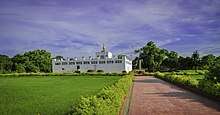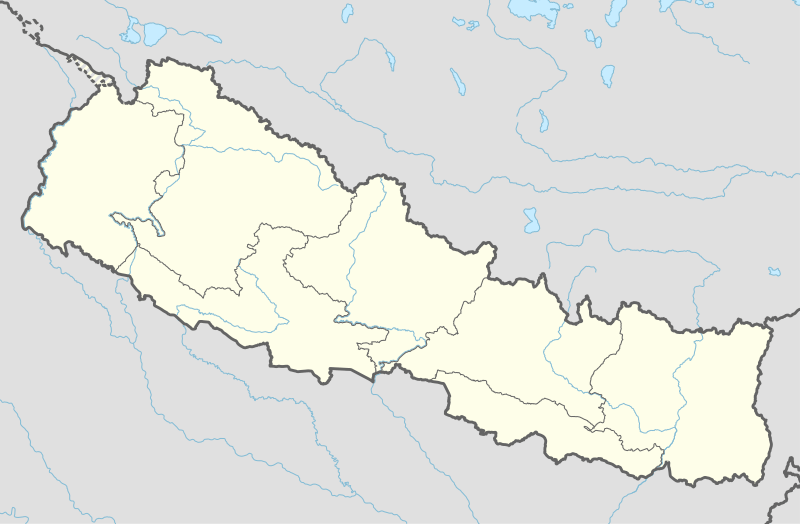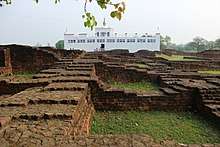Maya Devi Temple, Lumbini
Maya Devi Temple is an ancient Buddhist temple situated at the UNESCO World Heritage Site of Lumbini, Nepal. It is the main temple at Lumbini, a site traditionally considered the birthplace of Gautama Buddha. The temple stands adjacent to a sacred pool (known as Puskarni) and a sacred garden. The archaeological remains at the site were previously dated to the third-century BCE brick buildings constructed by Ashoka.[1] A sixth-century BCE timber shrine was discovered in 2013.[2]
| Maya Devi Temple | |
|---|---|
 Maya Devi Temple at Lumbini, Nepal | |
| Religion | |
| Affiliation | Buddhism |
| Location | |
| Location | Lumbini |
| Country | Nepal |
 Location within Nepal | |
| Geographic coordinates | 27.469554°N 83.275788°E |
| Architecture | |
| Completed | 3rd century BCE (Maya Devi Temple) ~550 BCE (earlier shrine beneath) |
2013 discovery

In November 2013, an international team of archaeologists digging under the temple discovered the remains of an ancient tree shrine dated before 550 BCE. The researchers speculated that the site is the earliest evidence of Buddhist structures and the first archaeological evidence of Gautama Buddha's life.[3][4][5] The excavation was headed by Robin Coningham of Durham University, UK, and Kosh Prasad Acharya of the Pashupati Area Development Trust, Nepal.[3][4] According to Coningham, the shrine is "the earliest Buddhist shrine in the world."[5] The speculations of the researchers were widely reported in international press, to the dismay of the rest of the scientific community, who mostly have disputed the conclusions of the researchers. Julia Shaw, a lecturer in South Asian archaeology at University College London, cautioned that the shrine may represent pre-Buddhist tree worship, and that further research is needed. The conclusions drawn by the researchers were also heavily criticized by Buddhist scholar Richard Gombrich.[5][6]
Gallery
 Maya Devi Temple in 2006
Maya Devi Temple in 2006 Close up view of the top of Mayadevi Temple.
Close up view of the top of Mayadevi Temple.












 Mayadevi Temple Lumbini front view
Mayadevi Temple Lumbini front view
References
- "Lumbini, the Birthplace of the Lord Buddha". UNESCO. Retrieved 26 November 2013.
- Coningham, R.A.E.; K.P. Acharya; K.M. Strickland; C.E. Davis; M.J. Manuel; I.A. Simpson; K. Gilliland; J. Tremblay; T.C. Kinnaird; D.C.W. Sanderson (2013). "The earliest Buddhist shrine: excavating the birthplace of the Buddha, Lumbini (Nepal)". Antiquity. 338. 87: 1104–1123. Retrieved 26 November 2013.
- Varma, Subodh (26 November 2013). "New finds at Lumbini may push Buddha's birth to 6th century BC". The Times of India. Retrieved 26 November 2013.
- Morgan, James (26 November 2013). "'Earliest shrine' uncovered at Buddha's birthplace". BBC. Retrieved 26 November 2013.
- Vergano, Dan (25 November 2013). "Oldest Buddhist Shrine Uncovered in Nepal May Push Back the Buddha's Birth Date". National Geographic. Retrieved 26 November 2013.
- Gombrich, Richard (12 December 2013). "Recent discovery of "earliest Buddhist shrine" a sham?". Tricycle: The Buddhist Review. Retrieved 13 October 2017.
External links
| Wikimedia Commons has media related to Maya Devi Temple, Lumbini. |
Further reading
- Coningham RAE, Acharya KP, Strickland KM et al. (2013) The earliest Buddhist shrine: excavating the birthplace of the Buddha, Lumbini (Nepal). Antiquity 87: 1104–1123